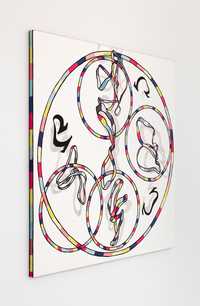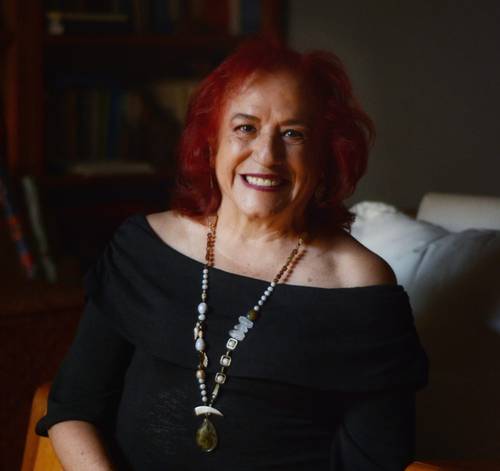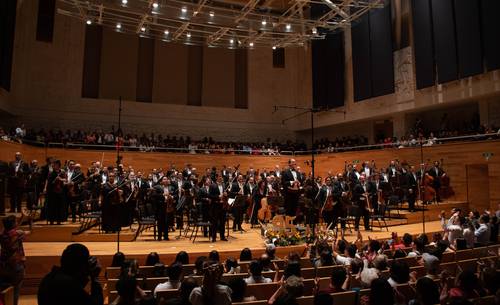Artist presents visual reflection on time

Artist presents visual reflection on time
Daniel López Aguilar
La Jornada Newspaper, Wednesday, August 20, 2025, p. 4
In his most recent exhibition, Pablo Vargas Lugo (Mexico City, 1968) proposes a visual reflection on time, its forms and its possible end.
The Omega exhibition is housed in the Labor gallery, where a monumental clock hangs from a knotted rope in the center of the space, as if time yielded to the weight of its symbols.
Cast in bronze, the main piece evokes the precision of Swiss watchmaking, the Greek letter that closes the Apocalypse, and the sacred syllable of Sanskrit.
"It has a wind-up, a case, a lid, and moon phases, but it doesn't tell the time. It's a hieroglyph," the artist explained in an interview with La Jornada .
"Its mechanism doesn't regulate energy, but rather symbolizes a definitive exit, represented by the knot that holds the structure together. Some perceive it as a bell, a hypnotic pendulum, or a wrecking ball."
The installation is complemented by three collages that seem to burst from their center: fragments of Tibetan mandalas whose colorful margins deform into a three-dimensional space.
The circular figures abandon their usual order to expand into shapes reminiscent of gears or encrypted writing. For Vargas Lugo, these works reflect the tension between external, linear time and internal, subjective time.
"Different visions of time coexist: the Judeo-Christian, which moves toward the final judgment; the Buddhist, which considers time an illusion; and the scientific, which, despite its logic, is unsatisfactory. Omega also refers to the end of time and history," he added.
“Although the image of the clock has been a constant in my work, this time it takes on a more intimate emotional charge. Before, I saw time as something abstract; now I experience it in everyday life. I feel it in my body, in my children, in those who are no longer with us.”

▲ One of the Omega mandalas, an exhibition by Pablo Vargas Lugo installed at the Labor gallery. Photo courtesy of Ramiro Chaves.
The montage opens up a range of interpretations: warning or contemplation? Irony or allegory of the outcome? Is it possible to strangle time without extinguishing consciousness? “There's an initial shock, then a dark humor. The work suggests that perhaps we shouldn't take it so seriously,” the artist commented.
“In collages , circularity breaks down and the center shifts. There is no direction toward revelation, but rather a constant drift. The symbolic order fragments into a visual grammar that oscillates between mental flow and dispersed code. The 'grand complications' of watchmaking become diagrams in flight. I don't seek to represent states of the soul, but rather the impulses that compel us to seek them out.”
"Beyond its material dimension, the exhibition is located at a crossroads where science, belief, and inner perception converge. It suggests the collapse of old cultural consensuses, the return of discarded ideas, and the temptation of premature closure.
"Time is something we experience, but don't understand. All creative obsessions fit into that gap," the artist concluded.
Omega can be visited on Mondays and Tuesdays from 11 a.m. to 6 p.m., and on Fridays and Saturdays from 11 a.m. to 3 p.m., at the Labor Gallery (General Francisco Ramírez 5, Ampliación Daniel Garza neighborhood, Miguel Hidalgo City Hall). Admission is free and the exhibition will remain open until September 7.
Two decades of María del Socorro Soto Alanís' poetry are compiled.

▲ A January Afternoon: Poetic Anthology (1998-2018) , by María del Socorro Soto Alanís, will be presented today in the main auditorium of the UACM Book Fair. Photo courtesy of the author.
Daniel López Aguilar
La Jornada Newspaper, Wednesday, August 20, 2025, p. 4
In the course of two decades of writing, the poet María del Socorro Soto Alanís (Durango, 1956) brings together her voice in A January Noon: Poetic Anthology (1998-2018) , published by Verso Destierro, the Juárez University of the State of Durango and the municipality of Durango.
The volume, which will be presented today at 6:00 p.m. at the Autonomous University of Mexico City (UACM) Book Fair, at the Del Valle campus, contains nearly 100 poems selected by the author along with troubadours Adriana Tafoya and Carlos Yescas.
Leap into the void
"I decided to compile the best of my previous books; it was like taking a leap of faith, but accompanied by two accomplices who helped me discern which pieces would stand the test of time," the author said in an interview with La Jornada .
An engineer by training and with studies in social sciences, philosophy, art history, and gender studies, the poet recognizes herself as a northern voice who writes from the desert and the memory of an arid territory, "always summoned by the nostalgia for water."
In its pages, the intimate and the political intersect. "I write about what I love and what I suffer, but I also speak out against injustice; when political discourse is empty, poetry must speak out what others keep silent," he added.
In the prologue, Adriana Tafolla cautioned that it is still too early to gauge Soto's influence on the younger generations, but she acknowledges that he has established a fruitful dialogue with younger poets such as Mónica Rebeles, Gabriela Sofía Magallanes, and Atenea Cruz, and that he keeps alive the "electric chaos" of Durango's poetic tradition.
For Soto Alanís, this exchange is vital, since "there is a vein that unites us, from Nelly Campobello and José Revueltas to the poets of today. As León Felipe said, 'all the poets of the world create the same poem.'"
In this continuity, her work maintains that memory never surrenders. Hence, in her most recent collection of poems, the mourning for the dead of Juárez and the disappeared coexists with poems of love, childhood, and hope: “Poetry is resistance, but also tenderness; it's a way of embracing life when everything seems to be falling apart,” she affirmed.
The book is organized into sections that explore the elements of water, earth, fire, and wind, and reaches its symbolic peak in “Amazona,” the poem that, according to the author, condenses her biography: “There is the girl I was, the woman who dreamed, the one who dared to raise her voice against oblivion.”
A January afternoon: Poetic Anthology (1998-2018) will be presented today in the main hall of the UACM Book Fair (San Lorenzo 90, Colonia del Valle, Benito Juárez borough).
The Fandango by Arturo Márquez will resonate in Xalapa
Friday's concert in Veracruz will celebrate the 96th anniversary of the OSX.

▲ The Xalapa Symphony Orchestra with its principal conductor, Martin Lebel, at the end of one of its concerts at the Tlaqná Hall, its headquarters in the Veracruz capital. Photo courtesy of OSX
Eirinet Gómez
La Jornada Newspaper, Wednesday, August 20, 2025, p. 5
The Xalapa Symphony Orchestra (OSX) will celebrate its 96th anniversary with Fandango for Violin and Orchestra by Arturo Márquez, featuring Venezuelan violinist Alexis Cárdenas. The concert, which will take place on Friday, is a premiere in Xalapa and opens the second season in 2025.
“I am very proud to premiere a work by Arturo Márquez in Xalapa because he is one of Mexico's greatest living composers,” said Martin Lebel, the orchestra's director. “This violin concerto is a great work lasting more than 30 minutes.”
For Lebel, performing this piece—considered a tribute to tradition, celebration, dance, the stage, zapateado, and son—in a place where son jarocho and fandango are part of everyday life, has a special resonance.
During its second season, the OSX will participate in the 2025 Cervantino Festival, which will take place from October 10 to 26 in Guanajuato. There, it will be accompanied by renowned Xalapa tenor Javier Camarena and will perform major works such as Gustav Mahler's Symphony No. 9 and Johannes Brahms' Requiem .
Tribute to the UV Choir
The orchestra will also dedicate a concert to honor its sister group, the Veracruz University Choir, which celebrates its 75th anniversary this year. In this performance on November 28, they will perform Sergei Prokofiev's Alexandr Nevsky , a cantata for orchestra and choir in seven movements.
In addition, the 100th anniversary of the Xalapa Stadium will be celebrated on September 19 with pieces such as Chichén Itzá by María Teresa Prieto; Tres danzas valencianas by Alpuente; Sinfonietta by José Pablo Moncayo; Tribu by Daniel Ayala; and the city premiere of Concerto for Guitar Ensemble and Orchestra by Rodrigo Lomán.
Another of the OSX's anniversaries will be the 150th anniversary of the birth of French composer Maurice Ravel, with a concert that will include Symphony No. 8, Shéhérazade 3 songs and Alborada del Gracioso , as well as the participation of Alexis Cárdenas on the violin.
The programme also includes two special concerts featuring music from children's films, with a video mapping screening on 5 and 6 September. The UV Educational Concerts will take place on 1, 2 and 3 October, when Caprice basque for violin by Pablo Sarasate; Xylophone Concerto by Toshiro Mayuzumi; and Shéhérazade by Nikolai Rimsky-Korsakov will be performed.
The OSX will also perform a symphonic tribute to Juan Gabriel, "El diva de Juárez ," on September 12 and 13. The concert will feature singer Arturo de la Fuente and guest conductor David Pérez Olmedo.
“We've tried to maintain a balance between classical pieces and more contemporary and experimental works,” added Martin Lebel. “Our intention is for the orchestra to continue engaging with all audiences.”
Intricate tattoos discovered on 2,000-year-old frozen mummy
They correspond to the Pazyryk culture of Siberia and serve as an equivalent to modern designs.
Europa Press
La Jornada Newspaper, Wednesday, August 20, 2025, p. 5
Madrid. A frozen mummy more than 2,000 years old has preserved intricate tattoos dating back to the Pazyryk culture of Siberia, which serve as a counterpart to modern tattoos.
An international team of archaeologists used high-resolution digital imaging techniques to examine them and shed light on the individual craftsmanship of prehistoric Siberian tattooing for the first time. The findings are published in Antiquity .
Tattooing was widespread throughout prehistory, but the lack of surviving figures hampers its research. The so-called "ice mummies" of the Altai Mountains are an exception, as their deep burial chambers, lined with permafrost, sometimes preserve the skin of the buried.
“Tattoos from the Pazyryk culture—Iron Age herders from the Altai Mountains—have long intrigued archaeologists because of their elaborate figurative designs,” says lead author Gino Caspari of the Max Planck Institute for Geoanthropology and the University of Bern.
Despite this, detailed studies of tattoos are rare, as high-resolution images were previously unavailable. Therefore, most studies have relied on early schematic drawings of tattoos.
“Previous studies focused primarily on the stylistic and symbolic dimensions of these tattoos, with data derived primarily from hand-made reconstructions,” Caspari explains. “These interpretations lacked clarity regarding the techniques and tools used and focused less on individuals and more on the broader social context.”
In an effort to provide a more precise method for exploring ancient tattoos, archaeologists conducted a three-dimensional scan of a tattooed Pazyryk mummy using newly available near-infrared digital photography with submillimeter resolution.
Working with modern tattoo artists, they examined tattoos in greater detail than ever before, identifying the individual tools and techniques used in their creation.
Specialized trade
Researchers found that the tattoos on the right forearm were more detailed and technical than those on the left. This suggests that different tattoo artists, or the same tattoo artist at different stages of development, contributed to the artistry.
This indicates that tattooing was not simply a form of decoration for Pazyryk culture, but a specialized craft requiring formal training and technical skill.
“This study offers a new way of recognizing personal autonomy in prehistoric body modification practices,” says Caspari. “Tattooing is not only a symbolic decoration, but also a specialized craft that requires technical skill, aesthetic sensitivity, and formal training or apprenticeship.”
Images that come to life
By identifying the individual hands behind ancient tattoos for the first time, researchers show that prehistoric Siberian tattooists were no different from today's professionals.
“This made me feel much closer to seeing the people behind the art, how they worked, learned, and made mistakes,” Caspari concludes. “The images came alive.”
Michelangelo's The Last Judgment will be restored
Europa Press
La Jornada Newspaper, Wednesday, August 20, 2025, p. 5
Madrid. The Vatican will begin extraordinary maintenance work in 2026 on Michelangelo's Last Judgment fresco in the Sistine Chapel.
According to Paolo Violini, the new director of the Vatican Museums' Laboratory for the Restoration of Paintings and Wood Materials, in an interview with Vatican News , reported by Europa Press, the project is expected to last from January to March. During that time, scaffolding will be installed to cover the entire wall. He added that the goal of finishing in March is "to clear the wall before the beginning of Holy Week."
"There will be a dozen work platforms with elevators that, to reduce work times and avoid obstructing the public's view, will allow us to work with up to 10 or 12 people simultaneously and have a close-up view of the work," Violini noted.
He also indicated that this work will complement the regular maintenance performed annually using a mechanical lift, or "spider," adding that it is "necessary" due to the "impact of the large number of visitors" that the frescoes have.
Previously, Violini explained that the restoration of the Raphael Loggia, or Vatican Loggias, will be carried out with a five-year restoration project. It includes 14 sections of "exquisite" stucco and frescoes, the work of Giovanni da Udine and other collaborators.
jornada




